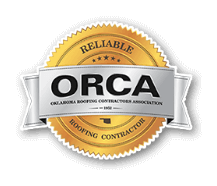In terms of popularity, slate roofing for residential properties is less common than asphalt shingles and other materials these days. However, they’ve been used for centuries because of their appearance and advantages. At Maupin Roofing, one thing we always tell our clients is that they should know everything about their chosen roofing material—the good and the bad—before having it installed or purchasing a house. So, we’ve put together a comprehensive guide that explains everything you should know about slate roofing. We hope the content below helps you make informed decisions in the future!
What Is a Slate Roof?
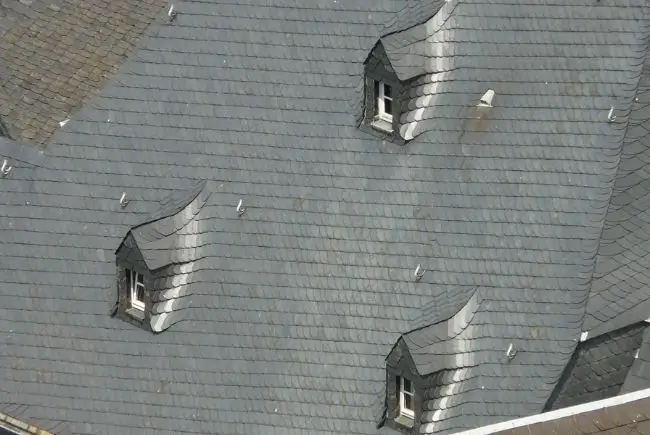
Slate tiles are a roofing material made from a natural stone called metamorphic rock that forms under heat and pressure over millions of years. Because of that process, slate ends up being incredibly dense and resilient.
After slate mining, larger slate pieces are usually used for blackboards, flooring, and countertops, while smaller pieces are split into thin, flat pieces and turned into slate shingles or tiles. These are attached to a roof deck on a sloped roof, creating a beautiful and extremely durable roofing system. Due to its organic origin, each slate tile is incredibly unique in appearance and texture.
Natural Slate Roofing vs. Synthetic Slate Roofs
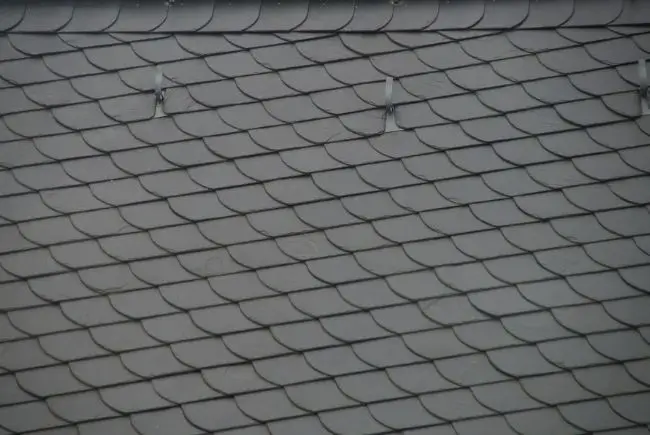
Modern synthetic slate roofs are designed to be nearly indistinguishable from natural slate at a glance. Since they’re made from composite materials like rubber or plastic, they don’t require extra reinforcement for your roof structure. They’re still more expensive than asphalt shingles, but they’re definitely cheaper than the natural material. In terms of lifespan, most synthetic slate roofs can last around 50-100 years, depending on the manufacturer.
On the other hand, a natural or traditional slate tile roof gives your home a timeless look that synthetic materials can’t fully replicate. If properly installed and cared for, it can last over 100 years, which is one of the longest lifespans among the most common roofing options. Unlike its synthetic version, real slate is heavy, meaning your roof will need additional structural support before installation. And of course, between materials and labor, natural slate roofing is one of the most expensive options out there.
Hard Slate Roofs vs. Soft Slate Roofs
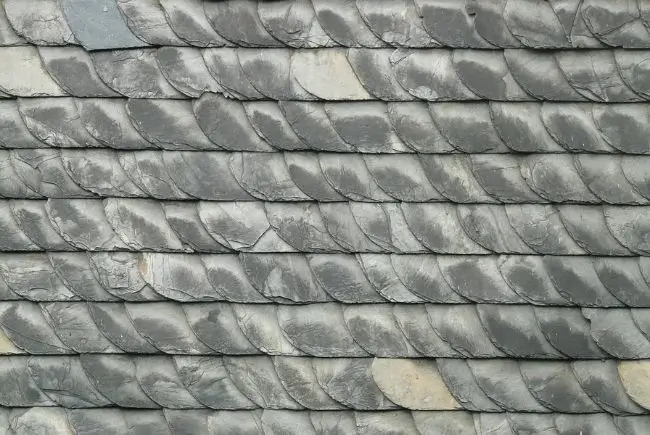
Hard slate is the most durable and resilient variety, with a lifespan of 75-200 years. It’s naturally fire resistant and can handle extreme weather as long as they’re installed properly. High durability means a higher price tag, but the long-term value is quite unbeatable.
Soft slate roofs usually last 50-125 years, depending on the quality. While still sturdy, soft slate wears down faster than hard slate. Now, if you want the look of natural slate roofing but don’t necessarily need a 200-year roof, soft slate is a great choice.
Slate Roof Pros and Cons for Residential Properties
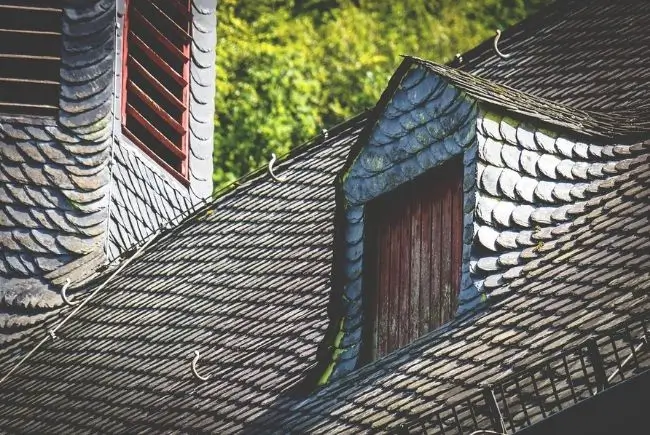
Like any roofing material, slate has its upsides and downsides. Consider these before making your decision:
Pros | Cons |
|---|---|
|
|
Different Types of Slate Roofing

Slate roofing comes in many styles. Find out which type works best for you and your home:
1. Standard Slate Roof Tiles
This is the most common type of slate roofing. The tiles are uniform in size and thickness, creating a neat and orderly appearance. This style works well for homeowners who prefer a clean and classic roof design.
2. Textural Slate Roofing
Textural slate has a rougher surface and appears more natural due to its varying thicknesses and uneven edges. This style may suit older homes better, though homeowners can still be creative and pair these types of slate tiles with more modern-style properties.
3. Graduated Slate Roofing
These slates use a mix of different tile sizes with the largest and thickest pieces at the bottom and smaller, thinner pieces toward the top. This method was traditionally used on historic buildings but can still be suitable for homes today, especially if you’re looking for an old-world and traditional appearance.
4. Patterned Slate Roofing
Some homeowners like to add decorative patterns by using different colors or shapes of slate tiles. Usually, these extra decorations are incorporated into standard slate roofs for easier and simpler installation. You can create just about any pattern including geometric patterns and even specific words or names.
Slate Roofing vs. Other Roofing Materials

Slate vs. asphalt shingles: Asphalt shingles are way cheaper but only last 20-30 years while slate can last a century or more.
Slate vs. metal roofing: Metal is durable and low-maintenance, but it doesn’t have the natural and timeless appearance of slate.
Slate vs. tile roof: Clay and concrete are similar in longevity to slate but tend to be slightly less resilient overall.
Still not sure which roofing material will work best for you? Contact us for a free project consultation!
How Much Does a Slate Roof Cost?

On average, slate costs $10-$30 per square foot including labor and materials. That’s $4,389-$22,377 for most projects. Ultimately, the total price depends on things like the size of your roof, the style of slate, and so on.
For a more accurate estimation of costs, contact us for a free quote.
Slate Roof Installation Process

Installing a slate roof system is quite similar to that of an asphalt roof. However, it’s still important to hire a professional slate roofer and reliable roofing companies in OKC to lead the installation process, because any errors or uncertainties could lead to costly repairs in the near future.
To get an idea of what a slate roof installation commonly looks like, this is what you can expect from a majority of roofing contractors or professionals:
1. Assessing Your Home’s Structure
Because slate is heavy, the first step is to have a professional check if your home’s structure can indeed handle all that weight. If reinforcement is needed, then that work must be done before the installation begins.
2. Preparing the Roof Deck
A solid roof deck with high-quality materials is important for a long-lasting roof. The best choice is typically 3/4-inch thick plywood or wooden boards, which provide a strong foundation for the slate tiles.
3. Installing Underlayment
Next, a waterproof underlayment is laid over the roof deck to protect it from moisture. The underlayment prevents leaks and extends the life of your roof.
4. Laying the Slate Tiles
The installer then lays down the slate tiles one by one, starting at the bottom and working upward. Each tile is nailed in place with copper or stainless steel nails to prevent corrosion over the years.
5. Adding Flashing
Flashing (typically made of copper) is installed around roof valleys, chimneys, and other vulnerable areas to direct water away from the roof. Once everything is secured, your installer will do a final inspection to make sure there are no issues.
Need Slate Roofing? Call Maupin Roofing Today!
Maupin Roofing has years of experience in slate roof repair and installation, as well as other popular roofing materials. Our team can help you make the right choice and handle the installation with ease.
Get in touch with us today for a consultation and see if a slate roof is right for your home!

Types of Asphalt Shingles for Residential Homes
People tend to use asphalt shingles for residential homes because of their affordability and longevity. At Maupin Roofing, we’ve had numerous clients ask about the

Understanding and Resolving Issues with Roof Flashing
Your roof flashing is just as important as your entire roof system. When neglected, it can lead to some serious roofing issues that will require

Harnessing Natural Light for Commercial Spaces
Nothing beats the warmth of direct sunlight streaming into a workspace. In Oklahoma City, where there’s ample natural light, businesses have a golden opportunity to

Seasonal Gutter Cleaning: Year-Round Roof Protection Guide
Seasonal gutter cleaning is just as important as regular home maintenance. Ignoring your gutters means you can end up with a whole lot more than

8 Most Common Causes of Roof Leaks and How to Prevent Them
Unfortunately, the most common causes of roof leaks are not always immediately noticeable, making it hard for homeowners to know whether they’re actually dealing with

Clay Tile Roofing for Homes: Everything You Need to Know
Interested in clay tile roofing for homes? There are a few things you should know about it, and Maupin Roofing is here to lay everything





